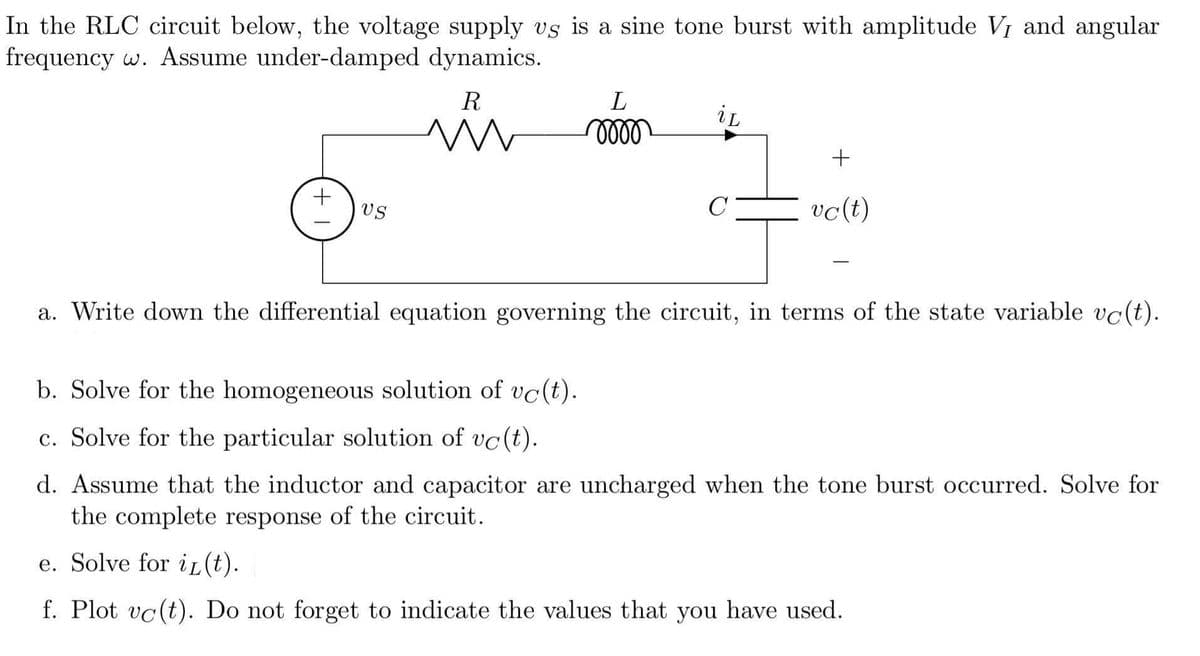In the RLC circuit below, the voltage supply vs is a sine tone burst with amplitude V₁ and angular frequency w. Assume under-damped dynamics. R L iL ww mooo + US vc(t) a. Write down the differential equation governing the circuit, in terms of the state variable vo(t). b. Solve for the homogeneous solution of vc(t). c. Solve for the particular solution of vc(t). d. Assume that the inductor and capacitor are uncharged when the tone burst occurred. Solve for the complete response of the circuit. e. Solve for iL(t). f. Plot vc(t). Do not forget to indicate the values that you have used.
In the RLC circuit below, the voltage supply vs is a sine tone burst with amplitude V₁ and angular frequency w. Assume under-damped dynamics. R L iL ww mooo + US vc(t) a. Write down the differential equation governing the circuit, in terms of the state variable vo(t). b. Solve for the homogeneous solution of vc(t). c. Solve for the particular solution of vc(t). d. Assume that the inductor and capacitor are uncharged when the tone burst occurred. Solve for the complete response of the circuit. e. Solve for iL(t). f. Plot vc(t). Do not forget to indicate the values that you have used.
Chapter15: Alternating-current Circuits
Section: Chapter Questions
Problem 63CP: A 20 resistor, 50F capacitor, and 30-mH inductor are connected in series with an ac source of...
Related questions
Question
Please answer a-c and explain a little

Transcribed Image Text:In the RLC circuit below, the voltage supply vs is a sine tone burst with amplitude V, and angular
frequency w. Assume under-damped dynamics.
R
L
il
m
mom
+
US
vc (t)
a. Write down the differential equation governing the circuit, in terms of the state variable vc(t).
b. Solve for the homogeneous solution of vc(t).
c. Solve for the particular solution of vc(t).
d. Assume that the inductor and capacitor are uncharged when the tone burst occurred. Solve for
the complete response of the circuit.
e. Solve for i(t).
f. Plot vc(t). Do not forget to indicate the values that you have used.
+
Expert Solution
This question has been solved!
Explore an expertly crafted, step-by-step solution for a thorough understanding of key concepts.
Step by step
Solved in 3 steps

Knowledge Booster
Learn more about
Need a deep-dive on the concept behind this application? Look no further. Learn more about this topic, physics and related others by exploring similar questions and additional content below.Recommended textbooks for you


College Physics
Physics
ISBN:
9781285737027
Author:
Raymond A. Serway, Chris Vuille
Publisher:
Cengage Learning

College Physics
Physics
ISBN:
9781305952300
Author:
Raymond A. Serway, Chris Vuille
Publisher:
Cengage Learning


College Physics
Physics
ISBN:
9781285737027
Author:
Raymond A. Serway, Chris Vuille
Publisher:
Cengage Learning

College Physics
Physics
ISBN:
9781305952300
Author:
Raymond A. Serway, Chris Vuille
Publisher:
Cengage Learning

Physics for Scientists and Engineers with Modern …
Physics
ISBN:
9781337553292
Author:
Raymond A. Serway, John W. Jewett
Publisher:
Cengage Learning

Physics for Scientists and Engineers
Physics
ISBN:
9781337553278
Author:
Raymond A. Serway, John W. Jewett
Publisher:
Cengage Learning

Glencoe Physics: Principles and Problems, Student…
Physics
ISBN:
9780078807213
Author:
Paul W. Zitzewitz
Publisher:
Glencoe/McGraw-Hill